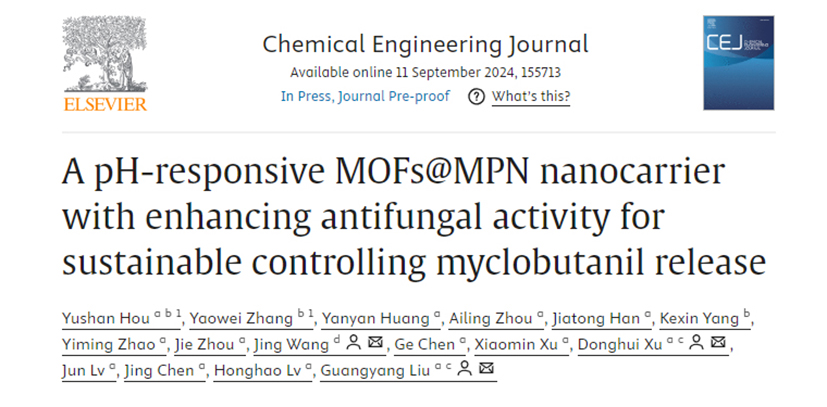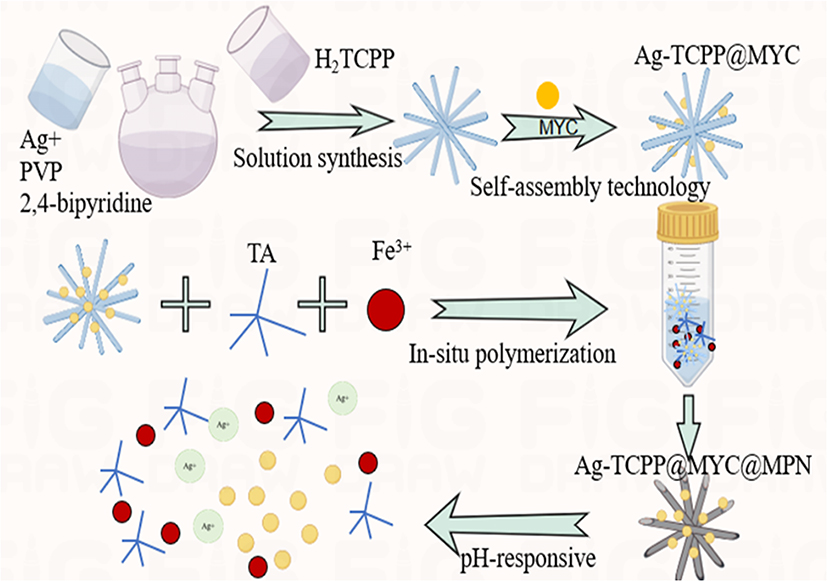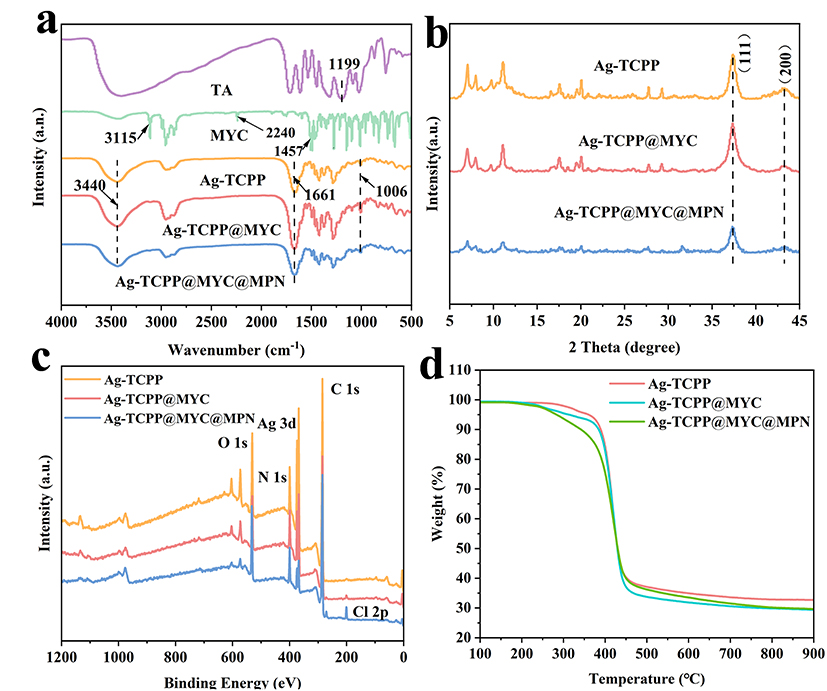Recently, the Quality and Safety Research Group of the Institute of Vegetables and Flowers, Chinese Academy of Agricultural Sciences (CAAS) has made important progress in the development of novel MOFs porous nanocarriers, sustained controlled release of myclobutanil and enhancement of pesticide utilization. The relevant research results are entitled in Chemical Engineering Journal (IF=13.3, Q1).

Myclobutanil (MYC) is a systemic triazole fungicide that inhibits ergosterol biosynthesis in pathogenic bacteria (basidiomycetes and ascomycetes) and is widely used to control various fungal diseases in fruits, cereals, vegetable crops, lawn care, and wood preservation. Pesticide residues caused by excessive application of MYC will endanger the quality and safety of agricultural products, as well as have ecological exposure risks and toxicological effects on pollinators of non-target organisms. Pesticide residues caused by excessive application of MYC will endanger the quality and safety of agricultural products, as well as have ecological exposure risks and toxicological effects on pollinators of non-target organisms. The development of novel porous nanocarriers for efficient loading and controlled release of myclobutanil can effectively increase the utilization and biocompatibility of pesticides, as well as significantly reduce the number of pesticide applications and inputs, reduce pesticide residues, and improve the quality and safety of agricultural products.

Fig.1 The synthesis schematic illustration of Ag-TCPP@MYC@MPN
Metal-organic frameworks (MOFs) are porous crystalline materials with great application potential in pesticide recognition and adsorption, detection and analysis, and loading and delivery. In recent years, novel porphyrin MOFs prepared with porphyrin and its derivatives as functional ligands have exhibited excellent environmental stability and biocompatibility and have become a hot spot for pesticide nanocarrier research. However, most vegetable surfaces contain hydrophobic wax layers, which weakens the adhesion of porphyrin MOFs carriers and reduce the deposition of pesticides. The functional modification of porphyrin MOFs is an effective means to solve the above problems. Tannic acid (TA), a natural polyphenolic compound derived from various plants, is rich in catechol groups and can be coordinated with different multivalent metal ions and assemble into a metal-phenol network (MPN), which rapidly deposits on the porphyrin MOFs surface. The strong adhesion of MPN can enhance the adhesion of the carrier, prolong the retention time, and improve the utilization rate of pesticides.

Fig.2 Nanostructure characterization of Ag-TCPP, Ag-TCPP@MYC and Ag-TCPP@MYC@MPN
Based on the above design, silver-based MOFs (Ag-TCPP) were used as porous nanocarriers for efficient loading of metronidazole (MYC) and a metal-phenolic network (MPN) via in-situ polymerization to construct a pH-responsive nano-delivery system (Ag-TCPP@MYC@MPN). Its load/release performance, light stability, adhesion, biosafety, and antibacterial activity were deeply explored. The results showed that Ag-TCPP@ MYC@MPN presented a disordered nanoflower structure, and the cumulative release rates of nanoparticles at pH 4.96, 7.5, and 8.5 were 52.6%, 62.6%, and 80.0%, respectively, which indicated that the system has a slow release rate and pH responsiveness. In addition, the antifungal activity of Ag-TCPP@MYC@MPN was significantly enhanced than that of MYC and Ag-TCPP@MYC. This could be attributed to the nanocarrier, which can not only control the slow release of MYC and increase the environmental stability and persistence of pesticides but also slowly release tannic acid and Ag+ in the carrier, resulting in a synergistic antibacterial effect. Safety experiments showed the nanoparticles had no inhibitory effect on the germination of Pakchoi seeds. After 14 days of application of Ag-TCPP@MYC@MPN, the residue of myclobutanil on Chinese cabbage was 0.05 mg/kg, which met the relevant requirements of'Maximum Residue Limits for Pesticides in Foods' (GB2763). This work provides research ideas for the preparation of novel stimulus-responsive porous nanocarriers, and provides technical support for improving pesticide utilization, reducing pesticide residues in vegetable products, and ensuring the quality and safety of agricultural products.

Fig. 3. The cumulative release profiles under different pH (a), and the corresponding fitting curves from First-order model (b); the retention amount of MYC SC, Ag-TCPP@MYC, and Ag-TCPP@MYC@MPN on leaf surface of pakchoi and rape (c); the residual rate of different samples after simulated rain scours (d).
The Institute of Vegetable and Flower Research, Chinese Academy of Agricultural Sciences (CAAS) was the first author of the paper, and Prof. Hou Yusan and Prof. Zhang Yaowei, Joint Master of Northeast Agricultural University (NEAU) were the joint first authors, Prof. Liu Guangyang, Prof. Wang Jing (Institute of Agricultural Quality Standards and Testing Technology, Chinese Academy of Agricultural Sciences (CAQST), and Prof. Xu Donghui were the co-corresponding authors, and Prof. Lv Honghao, cabbage Group, provided the important support for this study. The research was carried out in the State Key Laboratory of Vegetable Biological Breeding and Key Laboratory of Vegetables Quality and Safety Control, supported by National Key Research and Development Program of China, the National Bulk Vegetable Industry Technology System, Beijing Natural Science Foundation, and Agricultural science and technology Innovation Project of the Chinese Academy of Agricultural Sciences.
Web site of the paper: https://www.sciencedirect.com/science/article/pii/S1385894724072048